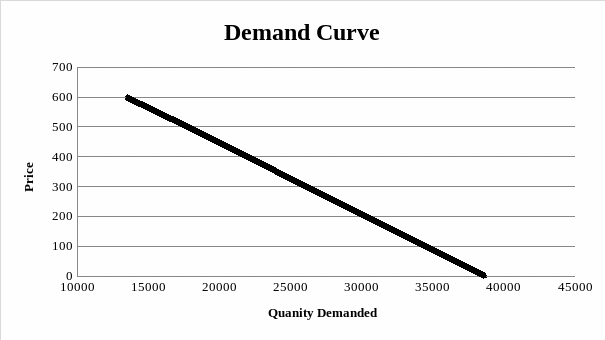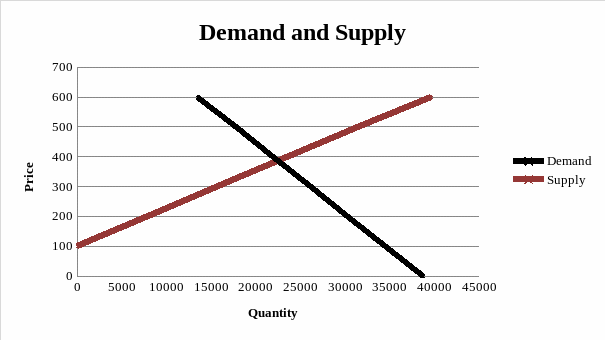For this assignment, Option 1 is selected, which investigates elasticities, demand, and supply of frozen microwaveable products based on the data from 26 supermarkets for the month of April.
Elasticities
Quantity demanded
QD = -5200 – 42P + 20Px + 5.2I +.20A +.25M
QD = -5,200 – (42 x 500) + (20 x 600) + (5.2 x 5,500) + (0.20 x 10,000) + (0.25 x 5,000)
QD = 17,650
Price elasticity
Price elasticity = -42 x 500 / 17,650 = -1.19
Cross-price elasticity
Cross-price elasticity = 20 x 600 / 17,650 = 0.68
Income elasticity
Income elasticity = 5.2 x 5500 / 17,650 = 1.62
Advertisement elasticity
Advertisement elasticity = 0.2 x 10,000 / 17,650 = 0.11
Microwave ovens elasticity
Microwave ovens elasticity = 0.25 x 5,000 / 17,650 = 0.07
Implications
The price-demand elasticity indicates that there is a negative relationship between price and demand for frozen microwaveable products as the value is -1.19. It implies that the demand for frozen microwaveable products increases by 1.19% when the price of these products decreases by 1%. It means that consumers will purchase more products if their price falls.
The cross-price elasticity indicates that the relationship between frozen microwaveable products and competitor products is inelastic, which implies that the demand for frozen microwaveable products increases by 0.68% when the price of competitor products increases by 1%. The products are inelastic because the value of cross-price elasticity is very small and the change in the demand for frozen microwaveable products is not significant (Hubbard, Garnett, & Lewis, 2014).
The income elastic of demand indicates that the relationship between income and demand for frozen microwaveable products is positive. It implies that the demand for products increases by 1.62% when the income of consumers increases by 1%. The results suggest that frozen microwaveable products are luxury items as consumers will purchase more of them when they have higher income for spending.
Although the advertisement elasticity value is very small, it indicates a positive relationship between advertisement expense and demand for frozen microwaveable products. It implies that if the company allocates funds for advertising its products, then it can achieve an increase in its sales (Boyes & Melvin, 2012). The change in demand will be small, and other factors such as the advertisement message and mediums of communication can also affect it.
The value of microwave over elasticity is very small, but it indicates a positive relationship between sales for microwaves and demand for frozen microwaveable products. It implies that the demand for frozen microwaveable products increased by 0.07% when the sales of microwaves increase by 1%.
Price Decision
The price decision of the company can be based on the value of price-demand elasticity. It is noted that the value of price elasticity is negative, and if the company reduces the price of its products, then it is likely to have a positive impact on the demand for them. Therefore, it is a favorable price decision that the company can make. Moreover, the value of price elasticity is more than one (Nechyba, 2016).
Therefore, the company can expect a higher change in the demand for frozen microwaveable products for a small change in their price. It also indicates that the company’s decision to lower its price will increase its sales of frozen microwaveable products and revenue. Moreover, the results indicated that the value of cross-price elasticity is very small. It means that the company’s decision to reduce the price of its products will have a positive impact on the demand for its products, but will not have any effect on the demand for competitors’ products (Boyes & Melvin, 2012). It is based on the inelasticity of the company’s products. Therefore, it could be concluded that the company should decrease the price of its products to take advantage of the market and achieve a higher income.
Equilibrium
The demand equation is obtained in the following by inserting the values of Px, I, A, and M.
QD = -5,200 – 42P + (20 x 600) + (5.2 x 5,500) + (0.20 x 10,000) + (0.25 x 5,000)
QD = 38650 – 42P
The demand curve is depicted in the following by using arbitrary values of price. It could be noted that the demand curve is downward sloping, which implies that the demand for microwaveable products decreases when the price of these product increases (Riley, 2012).

The supply equation is provided in the following.
QS = -7909.89 + 79.1P
Also, the supply curve is depicted in the following graph, which clearly implies that the quantity supplied increases when the price of these product increases.

The equilibrium price and quantity are calculated by equating the equations of quantity demanded and quantity supplied given above.
- 38650 – 42P = -7909.89 + 79.1P
- 121.1P = 46559.89
- P = 384.47
- Q = 38,650 – (42×384.47) = 22,502
The results indicate that the price and quantity of frozen microwaveable products are $384.47 and 22,502 respectively. At this level, the quantity demanded and quantity supplied are equal, and there is no excess in the market. The equilibrium level can be affected by both microeconomic and macroeconomic factors including income, advertisement, marketing, competitor products, microwave oven sales, inflation, population growth, etc.
In the given case, it could be indicated that the demand for frozen microwaveable products is affected positively by the increase in income, advertisement expense, and microwave oven sales. However, if the supply of frozen microwaveable products is limited, then the demand for these products can only increase to the level where the demand eventually becomes equal to the supply (Mankiw, 2012).
Factors affecting Equilibrium
There are various other factors that could affect the demand for frozen microwaveable products, which are not included in this analysis. These factors could include changes in consumer behavior, preferences, tastes, and views about these products. Moreover, macroeconomic factors including government policies, inflation, and economic growth, etc. can also affect the demand for frozen microwaveable products. Any change in these factors can affect the demand for microwaveable products, which will shift the demand curve and the equilibrium level will also change. Additionally, it could be stated that the demand for substitute products can also affect the demand for frozen microwaveable products.
The supply curve can shift if the number of suppliers increase or technology used in the production of frozen microwaveable products improves. Other factors including a reduction in taxes and materials’ cost can affect the supply of microwaveable products (Taussig, 2013).
References
Boyes, W., & Melvin, M. (2012). Economics. Mason, OH: Cengage Learning.
Hubbard, R. G., Garnett, A. M., & Lewis, P. (2014). Microeconomics. Frenchs Forest, NSW: Pearson Australia.
Mankiw, N. G. (2012). Brief principles of macroeconomics. Mason, OH: Cengage Learning.
Nechyba, T. (2016). Microeconomics: An intuitive approach. Boston, MA: Cengage Learning.
Riley, J. G. (2012). Essential Microeconomics. New York, NY: Cambridge University Press.
Taussig, F. W. (2013). Principles of Economics. New York, NY: Cosimo, Inc.